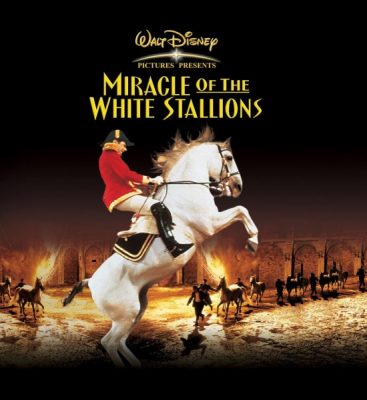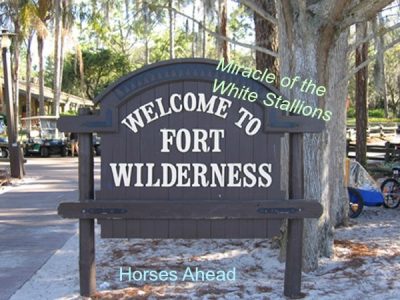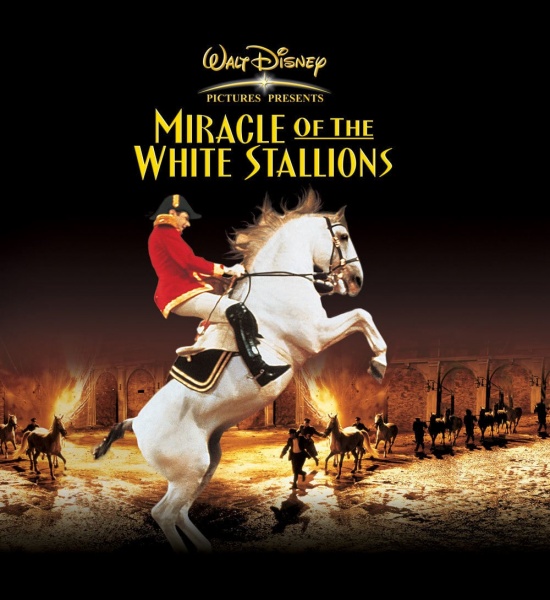
Based generally on the events towards the end of World War II that resulted in “Operation Cowboy,” where American troops rescued horses being horded by the Germans in Czechoslovakia from advancing Soviet troops, (1) and specifically on Alois Podhajsky’s autobiographical novel The Dancing White Horses of Vienna, Disney’s Miracle of the White Stallions was theatrically released on March 29, 1963. The live action drama is 118 minutes in length.
Plot Summary
In the waning months of World War II, Colonel Alois Podhajsky (Robert Taylor), head of the famed Spanish Riding School in Vienna, Austria, fears for the fate of the school’s prized Lipizzaner stallions as well as for the future of the school itself. The physical school and the stallions are directly threatened by Allied bombings, and the stallions are indirectly imperiled by the likelihood of the advancing Soviet army eating the school’s mares as it moves through Czechoslovakia, where the mares and some stallions are being sheltered. Fortunately for Podhajsky and the school, numerous people, including Podhajsky’s wife, Vedena (Lilli Palmer); Podhajsky’s rider Otto (Eddie Albert); German General Tellheim (Curd Jürgens); a railroad dispatcher (Philo Hauser); a railroad engineer (Max Haufler); the leader of a refugee camp at St. Martins, Austria, Countess Arco-Valley (Brigitte Horney); and horse lovers in the United States army, most notably Colonel Reed (Philip Abbott) and General George S. Patton (John Larch), seemingly understand the importance of saving the horses and expend extra energy to help the cause. Still, however, Patton and his troops are charged with culminating the deadliest conflict in human history, so they can only worry so much about the horses, which are nonetheless a major aspect of “Operation Cowboy.” Will the Spanish Riding School and its horses be preserved for posterity?
Acting
Overall, the acting in Miracle of the White Stallions is excellent. Palmer is slightly awkward as Vedena, but Taylor is brilliant as Podhajsky, and Jürgens and Larch are great as Tellheim and Patton, respectively. Taylor’s voice and demeanor remind me of Disney Legend Dean Jones for some reason.
Disney and World War II
Although Walt Disney did not fight directly in the Second World War, his studio aided the American war effort in two ways. First, Disney produced numerous features for different audiences. Most of these productions, including “The Rules of the Nautical Road,” “Protection Against Chemical Warfare,” “Glider Training,” “Automotive Electricity for Military Vehicles,” “Food Will Win the War,” and “Out of the Frying Pan into the Firing Line,” were created specifically for usage by the United States government and military and were, thus, not seen by the general public. (2) Some short films, including “Donald Gets Drafted,” “Commando Duck,” “Reason and Emotion,” “Education for Death,” “Der Fuehrer’s Face,” and “The New Spirit,” and one full length feature, Victory Through Air Power (1943), were, however, consumed by the masses and often augmented the patriotic spirit of their viewers. (3)
In addition to the production of films, the Disney Studio aided the war effort by quartering soldiers in the physical studio. Troops arrived at the studio on December 8, 1941, the day after the Japanese bombing of Pearl Harbor, and remained on the premises for eight months. (4) In perhaps the most bizarre situation of the eight-month period, Navy Commander Raymond Farwell accepted Walt Disney’s offer to lodge in his office suite until accommodations could be procured elsewhere in Burbank; these accommodations never transpired, and Farwell remained in Disney’s office until August 1942, sleeping in Disney’s bed and “[making] a habit of walking through busy staff meetings in Disney’s office lugging a jar of pickles and dropping crumbs from an oversized sandwich.” (5)
The Disney Studio was hardly a happy place during World War II. The combination of the studio occupation, payment delays for both usage of the studio and for the government-initiated films, conflicting advice from military advisors on whether the films should be entirely serious or incorporate some humor, and the drafting of his animators when they were needed to create the films frustrated Walt Disney, but the studio patriarch nonetheless tolerated these problems to support the war effort. (6)
Interestingly, as Disney complained about the drafting of his animators, (7) Podhajsky becomes angered early in Miracle of the White Stallions when General Stryker (Charles Régnier) orders the return of numerous riders at the Spanish Riding School to the army. Here, Podhajsky retorts, “You want the riding school to continue, and yet you take my staff away from me?!”
Perseverance
The major theme of Miracle of the White Stallions is perseverance. Through sheer determination, an inability to take “no” for an answer, and the intervention of a diverse set of people in favor of the cause, Podhajsky ultimately succeeds at his goal of saving the Spanish Riding School. Podhajsky’s energy in this regard is occasionally off-putting—he struggles to realize that people are concerned about their own lives and can only care so much about horses—but is nonetheless impressive.
Deference, Resistance, and Tradition
Throughout time, social stability has hinged on the willingness of inferiors to defer to the authority of their superiors. The young men assigned to the Spanish Riding School at the beginning of Miracle of the White Stallions show such deferential respect for Podhajsky, thanking the colonel for his tough but fair demeanor, and in an instance where Podhajsky regretfully directs his anger at General Stryker to one of the young men, said youth eschews talking back to Podhajsky, instead eagerly asking another rider in the room to note further errors such that he can improve his craft.
Of course, deference can sometimes lead to a person’s downfall. Deference is crucial to the proper functioning of an army, and all involved on the losing side of a war face punishment at the hands of the victors for following orders. Such a fate is represented in Miracle of the White Stallions by General Tellheim, who, seeing the imminence of an Allied victory, admits to Podhajsky in St. Martins that he regrets “selling” himself to Hitler. He wishes that he, and the Austrian people generally, had shown more strength in opposing Nazism, a battle that was easier before the escalation of the war but is nonetheless still possible. Tellheim’s description of a “strong” person, one who is still willing to fight despite seemingly insurmountable odds, essentially reflects Podhajsky’s character: “Strong people fight in spite of everything; they risk themselves for what they believe in; I admire them; I…I envy them, no matter what happens to them.”
Deference is tied with tradition because both concepts emphasize respect for established people, ideas, and institutions. If such people, ideas, and institutions are toppled or forgotten, the soul of a society is corrupted. This concern provides one rationale for Podhajsky’s unceasing efforts to save the Spanish Riding School—with the destruction caused by the Second World War, some sense of stability is needed for recovery, and the centuries-old legacy of the Spanish Riding School serves this purpose for the Austrian people.
Action
Miracle of the White Stallions incorporates sporadic action scenes. Along the way, the protagonists escape unscathed bombings on both Vienna and on the railroad line between Vienna and St. Martins, and desperate refugees in St. Martins attempt to steal supplies and horses for food and transportation.
Not especially exciting, though perhaps beautiful for those interested in equestrian activity, are the film’s two extended horse show scenes—one of these segments occurs towards the end of the film in St. Martins in an attempt to convince General Patton to help save the Spanish Riding School; and the other such segment occupies the film’s final ten or so minutes inside the Spanish Riding School arena. The latter sequence occurs in 1955, ten years after the events of the rest of the film, after the culmination of the Allied occupation of Austria.
Music
Richard and Robert Sherman, the great Disney composer brothers, who were named Disney Legends in 1990, wrote a beautiful song, “Just Say Auf Wiedersehen,” for Miracle of the White Stallions. This number, performed lyrically by Otto at a farewell dinner for the departing riders early in the film, soothingly expresses the hope that those gathered will meet again someday. The tune is thereafter brilliantly used instrumentally as Podhajsky and his wife walk across the barren arena of the riding school before their evacuation to St. Martins. Indeed, the colonel and his school will, against all odds, meet again.
Humor
Miracle of the White Stallions is not a comedy, but the young members of the United States army, who arrive in St. Martins towards the end of the film, provide some laughs. A joke about the Austrian location of the Spanish Riding School and a discussion between one of the soldiers and Vedena about stale fudge are both amusing.
Relationship to Other Disney Films
Horses were also prominently featured in The Littlest Outlaw (1955), Tonka (1958), The Horse in the Gray Flannel Suit (1968), Ride a Wild Pony (1975), The Young Black Stallion (2003), and Secretariat (2010).
Almost Angels (1962) was also set in Austria; and Bambi (1942), Perri (1957), and The Shaggy Dog (1959, 2006) were based on books by an Austrian-born author, Felix Salten.
In the Parks
Horseback riding is among the recreational activities available at the “Tri-Circle-D Ranch” at Walt Disney World’s Fort Wilderness Resort and Campground.

Adventures by Disney offers several itineraries that include Austria.
Overall
Miracle of the White Stallions is a good, if slightly long, family movie, amalgamating real historical events, beautiful animals, and an intriguing story.
Notes
1) Susan Davis, “Operation Cowboy: In 1945 a Group of U.S. Soldiers Liberated 375 Lipizzans from Nazi Captivity,” Sports Illustrated, October 16, 1995, accessed January 27, 2019, https://www.si.com/vault/1995/10/16/207260/operation-cowboy-in-1945-a-group-of-us-soldiers-liberated-375-lipizzans-from-nazi-captivity.
2) Steven Watts, The Magic Kingdom: Walt Disney and the American Way of Life (Columbia, Mo.: University of Missouri Press, 1997), 229-30.
3) Ibid., 230-37.
4) Ibid., 228.
5) Ibid., 233.
6) Ibid., 228-39.
7) Ibid., 238.
What do you think of Miracle of the White Stallions? Let me know in the comments!
Sponsored Ad: Would you like to help support The Mouse For Less website in continuing their mission of being THE Disney vacation planning resource? You can do so by purchasing Miracle of the White Stallions from our Affiliate Link through Amazon. Thanks so much for your support!
Did you like this article? Make sure to share it with your friends! Check below for easy ways to share!
Incoming search terms:
- https://www themouseforless com/blog_world/movie-review-miracle-of-the-white-stallions/
- childrens movie live action big white horses mirror
- disney horse movie
- disney white stallion movie
- https://www themouseforless com/blog_world/movie-review-miracle-of-the-white-stallions/#:~:text=Miracle of the White Stallions is a good, if slightly animals, and an intriguing story
- https://www themouseforless com/blog_world/movie-review-miracle-of-the-white-stallions/#:~:text=Overall, the acting in Miracle of the White Stallions is excellent

